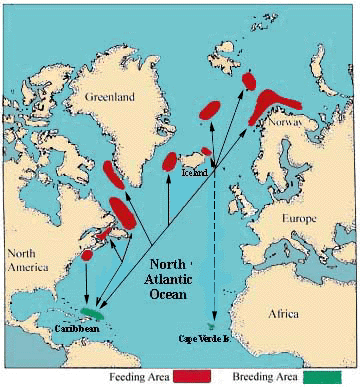The YoNAH Research Team
The Center for Coastal Studies is primarily responsible for work performed in two areas: the Gulf of Maine feeding ground and the West Indies breeding ground. The following is a full list of primary YoNAH participants (in alphabetical order):
| Research Institution | Country |
| Center for Coastal Studies | USA |
| College of the Atlantic | USA |
| Greenland Institute for Natural Resources | Greenland |
| Institute of Marine Research | Norway |
| Marine Research Institute | Iceland |
| Memorial University of Newfoundland | Canada |
| National Marine Fisheries Service, NEFSC | USA |
| Sea Mammal Research Unit | United Kingdom |
| University of Copenhagen | Denmark |

Known feeding and breeding grounds of the North Atlantic humpback whale. Lines indicate exchange between areas, not actual migration routes. ©Center for Coastal Studies
Selected YoNAH Findings:
Population size and trend The YoNAH project produced the first estimate of the size of the entire North Atlantic population–approximately 11,570 animals in 1993 (see Stevick et al. 2003). It also estimated the size of the West Indies breeding population (a major subset of the North Atlantic) to be 10,752 animals. Finally, the West Indies population was found to be growing at a rate of 3% at that time. Population estimates are important to the management and conservation of endangered species like the humpback whale. The YoNAH estimate will serve as a baseline against which to evaluate whether the population is increasing or decreasing over time. A subsequent project, known as MONAH, was undertaken in 2003-2005 to help to answer this question.
Population Structure YoNAH also provided detailed information on exchange between high-latitude feeding grounds and low latitude breeding grounds (see image, right). For example, it was once assumed that whales from Norway mated and gave birth in the eastern North Atlantic (the Cape Verde Islands). We now know that at least some of these whales mingle with whales from the western North Atlantic on the Caribbean breeding grounds. Individuals have been tracked between Norway and the Caribbean both by photographs of natural marks (see Stevick et al. 1998) and “genetic tags” (see Palsboll et al. 1997). Nevertheless, there are important differences in migratory timing among feeding areas, resulting in differences in how they overlap on the West Indies ground (see Stevick et al. 2003). As a result, whales from western North Atlantic may still have a lower likelihood of mating with the whales that do migrate there from eastern North Atlantic. The distribution and resightings of individuals across the North Atlantic suggest essentially four feeding aggregations: the Gulf of Maine, eastern Canada, West Greenland and the eastern North Atlantic (see Stevick et al. 2006). This is based on evidence of higher site fidelity and smaller movements in the western North Atlantic as compared to off Iceland and Norway. Detailed YONAH findings can be found in articles on our publication page.
The whale sighting data collected during the YoNAH project can be viewed at OBIS-Seamap

Our Work
Humpback Whale Research
Right Whale Research
Marine Animal Entanglement Response
Marine Geology Department
Water Quality Monitoring Program
Marine Fisheries Research
Seal Research
Shark Research
Marine Education
Interdisciplinary
Marine Debris and Plastics Program
Marine Policy Initiative
Cape Cod Climate Change Collaborative
Publications

